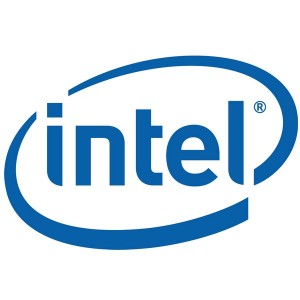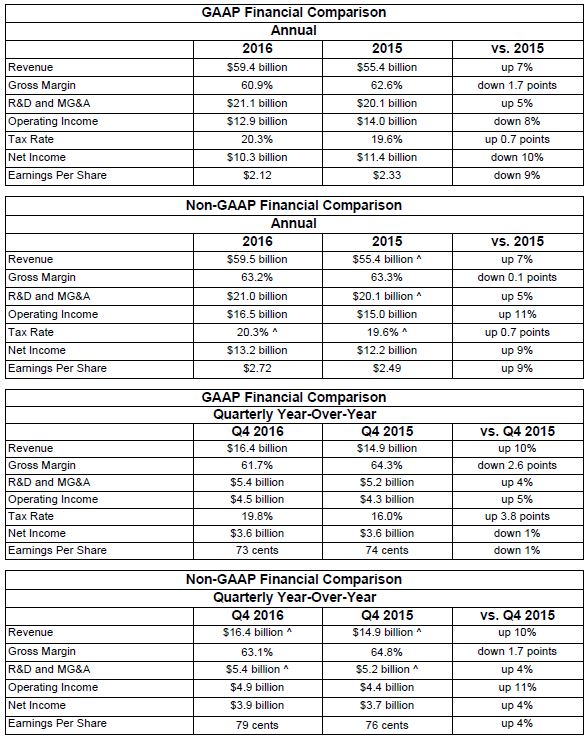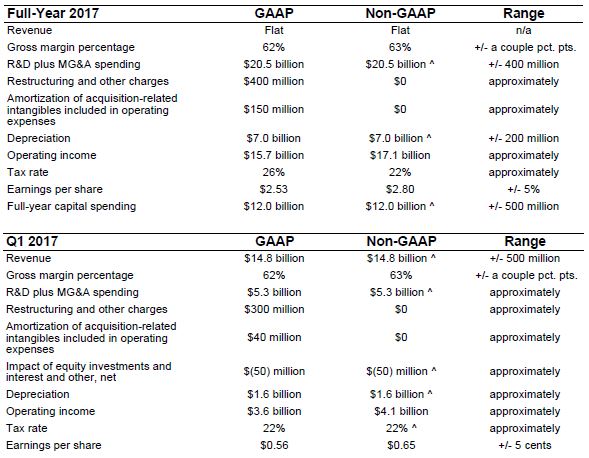Intel Reports Record Full-Year Revenue of $59.4 Billion in 2016
Intel Reports Record Full-Year Revenue of $59.4 Billion; Reports Record Quarterly Revenue of $16.4 Billion
News Summary:
- Revenue growth in 2016 driven by strength across the business including full-year revenue growth in Client Computing, Data Center, and Internet of Things
- Record annual cash flow from operations of $21.8 billion
- Solid earnings with GAAP net income of $10.3 billion; non-GAAP net income of $13.2 billion
SANTA CLARA, Calif., January 26, 2017 — Intel Corporation today reported full-year revenue of $59.4 billion, operating income of $12.9 billion, net income of $10.3 billion and EPS of $2.12. Intel reported non-GAAP revenue of $59.5 billion, operating income of $16.5 billion, net income of $13.2 billion, and EPS of $2.72. The company generated approximately $21.8 billion in cash from operations, paid dividends of $4.9 billion and used $2.6 billion to repurchase 81 million shares of stock.
For the fourth quarter, Intel posted revenue of $16.4 billion, operating income of $4.5 billion, net income of $3.6 billion and EPS of 73 cents. Intel reported non-GAAP operating income of $4.9 billion, net income of $3.9 billion, and EPS of 79 cents. The company generated approximately $8.2 billion in cash from operations, paid dividends of $1.2 billion, and used $533 million to repurchase 15 million shares of stock.
The fourth quarter was a terrific finish to a record-setting and transformative year for Intel. In 2016, we took important steps to accelerate our strategy and refocus our resources while also launching exciting new products, successfully integrating Altera, and investing in growth opportunities, said Brian Krzanich, Intel CEO. Im pleased with our 2016 performance and confident in our future.
Full-Year 2016 Business Unit Trends*
- Client Computing Group revenue of $32.9 billion, up 2 percent from 2015
- Data Center Group revenue of $17.2 billion, up 8 percent from 2015
- Internet of Things Group revenue of $2.6 billion, up 15 percent from 2015
- Non-Volatile Memory Solution Group revenue of $2.6 billion, down 1 percent from 2015
- Intel Security Group revenue of $2.2 billion, up 9 percent from 2015
- Programmable Solutions Group revenue of $1.7 billion
* The first quarter of 2016 had 14 weeks of business versus the typical 13 weeks, as the company realigned its fiscal year with the calendar year.
Q4 Business Unit Trends
- Client Computing Group revenue of $9.1 billion, up 4 percent year-over-year
- Data Center Group revenue of $4.7 billion, up 8 percent year-over-year
- Internet of Things Group revenue of $726 million, up 16 percent year-over-year
- Non-Volatile Memory Solution Group revenue of $816 million, up 25 percent year-over-year
- Intel Security Group revenue of $550 million, up 7 percent year-over-year
- Programmable Solutions Group revenue $420 million
^ No adjustment on a non-GAAP basis.
Business Outlook
Intels Business Outlook does not include the potential impact of any business combinations, asset acquisitions, divestitures, strategic investments and other significant transactions that may be completed after January 26, 2017, with the exception of our planned divestiture of the Intel Security Group, which we announced in the third quarter of 2016. Our guidance for 2017 assumes that such divestiture will close at the beginning of the second quarter.
Our guidance for the first quarter and full year of 2017 include both GAAP and non-GAAP estimates. Reconciliations between these GAAP and non-GAAP financial measures are included below.
^ No adjustment on a non-GAAP basis.
Restructuring and Other Charges Forecast
Consistent with our prior outlook, total restructuring and other charges are expected to be $2.3 billion. Approximately $1.9 billion was realized in 2016.
For additional information regarding Intels results and Business Outlook, please see the “CFO Commentary” document posted on our Investor Relations website at www.intc.com/results.cfm.
Status of Business Outlook
Intels Business Outlook is posted on intc.com and may be reiterated in public or private meetings with investors and others. The Business Outlook will be effective through the close of business on March 17, 2017 unless earlier updated; except that the Business Outlook for amortization of acquisition-related intangibles, impact of equity investments and interest and other, restructuring charges, and tax rate, will be effective only through the close of business on February 2, 2017. Intels Quiet Period will start from the close of business on March 17, 2017 until publication of the companys first-quarter earnings release, scheduled for April 27, 2017. During the Quiet Period, all of the Business Outlook and other forward-looking statements disclosed in the companys news releases and filings with the SEC should be considered as historical, speaking as of prior to the Quiet Period only and not subject to an update by the company.
Forward-Looking Statements
The above statements and any others in this release that refer to Business Outlook, future plans and expectations are forward-looking statements that involve a number of risks and uncertainties. Words such as “anticipates,” “expects,” “intends,” “goals,” “plans,” “believes,” “seeks,” “estimates,” “continues,” “may,” “will,” “would,” “should,” “could,” and variations of such words and similar expressions are intended to identify such forward-looking statements. Statements that refer to or are based on projections, uncertain events or assumptions also identify forward-looking statements. Such statements are based on management’s expectations as of the date of this earnings release and involve many risks and uncertainties that could cause actual results to differ materially from those expressed or implied in these forward-looking statements. Intel presently considers the following to be important factors that could cause actual results to differ materially from the company’s expectations.
- Demand for Intel’s products is highly variable and could differ from expectations due to factors including changes in business and economic conditions; consumer confidence or income levels; the introduction, availability and market acceptance of Intel’s products, products used together with Intel products and competitors’ products; competitive and pricing pressures, including actions taken by competitors; supply constraints and other disruptions affecting customers; changes in customer order patterns including order cancellations; and changes in the level of inventory at customers.
- Intel’s gross margin percentage could vary significantly from expectations based on capacity utilization; variations in inventory valuation, including variations related to the timing of qualifying products for sale; changes in revenue levels; segment product mix; the timing and execution of the manufacturing ramp and associated costs; excess or obsolete inventory; changes in unit costs; defects or disruptions in the supply of materials or resources; and product manufacturing quality/yields. Variations in gross margin may also be caused by the timing of Intel product introductions and related expenses, including marketing expenses, and Intel’s ability to respond quickly to technological developments and to introduce new products or incorporate new features into existing products, which may result in restructuring and asset impairment charges.
- Intel’s results could be affected by adverse economic, social, political and physical/infrastructure conditions in countries where Intel, its customers or its suppliers operate, including military conflict and other security risks, natural disasters, infrastructure disruptions, health concerns, fluctuations in currency exchange rates, sanctions and tariffs, and the United Kingdom referendum to withdraw from the European Union. Results may also be affected by the formal or informal imposition by countries of new or revised export and/or import and doing-business regulations, which could be changed without prior notice.
- Intel operates in highly competitive industries and its operations have high costs that are either fixed or difficult to reduce in the short term.
- The amount, timing and execution of Intel’s stock repurchase program could be affected by changes in Intel’s priorities for the use of cash, such as operational spending, capital spending, acquisitions, and as a result of changes to Intel’s cash flows or changes in tax laws.
- Intel’s expected tax rate is based on current tax law and current expected income and may be affected by the jurisdictions in which profits are determined to be earned and taxed; changes in the estimates of credits, benefits and deductions; the resolution of issues arising from tax audits with various tax authorities, including payment of interest and penalties; and the ability to realize deferred tax assets.
- Gains or losses from equity securities and interest and other could vary from expectations depending on gains or losses on the sale, exchange, change in the fair value or impairments of debt and equity investments, interest rates, cash balances, and changes in fair value of derivative instruments.
- Product defects or errata (deviations from published specifications) may adversely impact our expenses, revenues and reputation.
- Intel’s results could be affected by litigation or regulatory matters involving intellectual property, stockholder, consumer, antitrust, disclosure and other issues. An unfavorable ruling could include monetary damages or an injunction prohibiting Intel from manufacturing or selling one or more products, precluding particular business practices, impacting Intel’s ability to design its products, or requiring other remedies such as compulsory licensing of intellectual property.
- Intels results may be affected by factors that could cause the implementation of, and expected results from, the restructuring plan announced on April 19, 2016, to differ from Intels expectations. A detailed description of risks associated with the restructuring plan and factors that could cause actual results of the restructuring plan to differ is set forth in the Forward Looking Statements section of Intels press release entitled Intel Announces Restructuring Initiative to Accelerate Transformation dated April 19, 2016, which risk factors are incorporated by reference herein.
- Intel’s results may be affected by the timing of closing of acquisitions, divestitures and other significant transactions. In addition, risks associated with our planned divestiture of the Intel Security Group are described in the Forward Looking Statements section of Intels press release entitled “Intel and TPG to Collaborate to Establish McAfee as Leading Independent Cybersecurity Company Valued at $4.2 Billion” dated September 7, 2016, which risk factors are incorporated by reference herein.
Additional information regarding these and other factors that could affect Intel’s results is included in Intel’s SEC filings, including the company’s most recent reports on Forms 10-K and 10-Q, copies of which may be obtained by visiting our Investor Relations website at www.intc.com or the SEC’s website at www.sec.gov.
Earnings Webcast
Intel will hold a public webcast at 2:00 p.m. PDT today to discuss the results for its fourth quarter of 2016 and full year 2016. The live public webcast can be accessed on Intel’s Investor Relations website at www.intc.com/results.cfm. A webcast replay and audio download will also be available on the site.
Intel plans to report its earnings for the first quarter of 2017 on April 27 promptly after close of market, and related materials will be available at www.intc.com/results.cfm. A public webcast of Intels earnings conference call will follow at 2:00 p.m. Pacific Time at www.intc.com.
About Intel
Intel (NASDAQ: INTC) expands the boundaries of technology to make the most amazing experiences possible. Information about Intel can be found at newsroom.intel.com and intel.com.
Intel, the Intel logo, Core, and Ultrabook are trademarks of Intel Corporation or its subsidiaries in the United States and other countries.
**Other names and brands may be claimed as the property of others.



